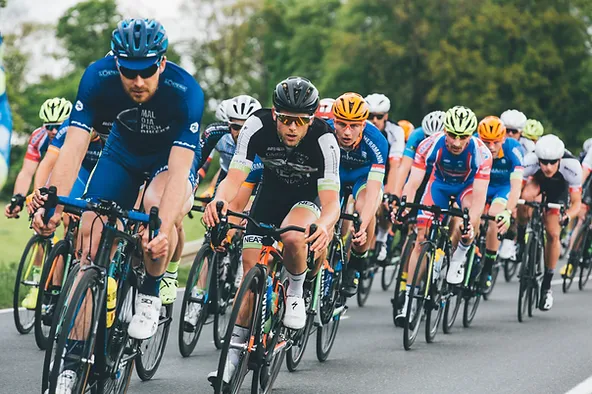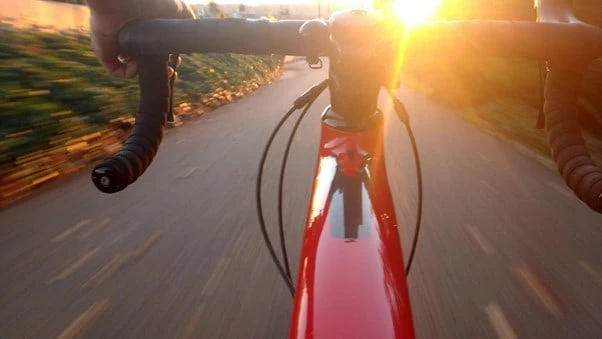Find out about the causes of, and treatments for, knee pain from cycling
When we think of cycling, we often associate it with being:
● Non-weight bearing
● Easy on the joints
● A low impact form of exercise
However, knee pain is a very common complaint reported by professional and amateur cyclists. Read on to discover how cycling can cause knee pain, the different kinds of cycling knee pain, and learn what you can do to treat this condition.
Cycling knee pain
Cycling knee pain can be caused by a variety of factors, including overuse, poor bike fit, and biomechanical issues. Understanding the causes of knee pain in cyclists can help you prevent and treat it effectively.
What is cycling knee pain?
Cycling knee pain is a type of pain that occurs in and around the knee joint while cycling. It can manifest as a dull ache, sharp pain, or a burning sensation. Knee pain can be felt in the front of the knee, behind the knee, or on the sides of the knee.
Does cycling cause knee pain?
Cycling shouldn’t cause knee pain on a conventional, day-to-day basis. However, active cyclists may notice knee pain when cycling or even knee pain after cycling.
There are three main reasons that cyclists might feel knee pain:
● Change in training intensity
● Change in equipment (bike-specific)
● Our intrinsic anatomical and biomechanical make-up (cyclist specific)

What types of knee pain can be caused by cycling?
Cycling can cause pain in many different parts of the knee. For example, some people suffer from:
● Anterior knee pain: the front of the knee
● Posterior knee pain: the back of the knee
● Lateral knee pain: the sides of the knee
Whether you’re suffering from outside knee pain from cycling or inside knee pain from cycling, a qualified physiotherapist will be able to diagnose and help to treat the problem.
What are the causes of cycling knee pain?
The knee is a hinge joint that is designed to move in only one plane, performing extension and flexion movements. Your quadriceps muscle group attaches to your tibia (shin bone) via your patella, with some muscles extending on the inside of your knee and others on the outside.
If there is a muscular imbalance between these muscles, it can cause the patella to track out of its groove and cause symptoms like pain, a feeling of instability, and/or a clicking sensation.
Cycling-induced knee pain is usually caused by tightness in the fibrous tissue that runs along the outside of your thigh, called your iliotibial band, which in turn pulls at your kneecap (patella). Cyclists use their quadriceps the most in the downward stroke, which is when the greatest amount of pressure is placed on the knee.
The link between knee pain and cycling seat height
The position of your bike seat is very crucial for having correct knee alignment when cycling. Not only is seat height important, but you also need to consider seat fore/aft and tilt to ensure all joints are in the correct position.

Preventing cycling knee Pain
Preventing knee pain is essential to maintaining an active and healthy cycling lifestyle. Proper bike fit, technique, and training can go a long way in preventing knee pain. Here are some tips to help you prevent cycling knee pain.
Preventing knee pain while cycling
Proper bike fit is the most crucial factor in preventing knee pain. A bike that is not properly fitted to your body can put excessive stress on your knees, leading to pain and discomfort. Some things to consider while ensuring proper bike fit include:
Correct saddle height: The saddle should be adjusted to a height that allows your knee to be slightly bent when your foot is at the bottom of the pedal stroke.
Optimal cleat position: The position of the cleats on your cycling shoes can affect the alignment of your knees. Ensure that your cleats are positioned in a way that is comfortable and does not cause undue stress on your knees.
Optimal pedal stroke technique: Proper pedal stroke technique can help reduce stress on your knees. Aim for a smooth and fluid pedal stroke that does not cause any jerking or sudden movements.
Recommended training plan: Gradual increase in mileage and intensity can help prevent overuse injuries. Follow a recommended training plan to gradually increase your cycling volume and intensity.
Strengthening exercises for cyclists
Strengthening exercises can help you prevent knee pain by building strength in the muscles surrounding your knee joint. Some exercises that are recommended for cyclists include:
Quadriceps strengthening exercises: Squats and lunges can help strengthen your quadriceps muscles, which are responsible for extending your knee.
Hamstring strengthening exercises: Deadlifts and hamstring curls can help strengthen your hamstring muscles, which are responsible for flexing your knee.
Glute strengthening exercises: Hip thrusts and squats can help strengthen your glute muscles, which are responsible for hip extension.
Common mistakes to avoid
Riding with a saddle that is too high or too far forward can put excessive stress on your knees, leading to knee pain. Also, overtraining or not allowing enough rest and recovery time can lead to overuse injuries. It’s essential to avoid these common mistakes to prevent cycling knee pain.
By following these tips, you can reduce the risk of developing knee pain while cycling. However, if you experience persistent knee pain, it’s important to consult a healthcare provider who can help diagnose the underlying cause and provide the necessary treatment.
Are there treatments for knee pain when cycling?
If you’re currently dealing with any sort of knee pain it is important to have it checked by a healthcare professional, so any related condition does not degenerate or progress into something worse. The podiatrists at Align Health Collective are all highly skilled and qualified to conduct the necessary knee assessments to determine the causing factors and educate you on the various treatment options.
Treatment options can vary from muscular retraining, strengthening, and releasing techniques on associated muscles as well as orthotic therapy, depending on the cause of pain. It is also recommended that you book in for a bike fit with someone who can assess your seat position as well as riding style and volume.
Talk to a professional about knee pain during cycling
If you’re cycling and suffering from knee pain, our team can help. We are also able to assist with cycling leg pain and all your other sports injuries.
If you have any further questions regarding knee pain, or if you are experiencing any other foot, ankle, or leg pain you can give us a call at (03) 9568 1011. Alternatively, you can book an appointment online to see one of our physiotherapists at www.alignhc.com.au.
Related Posts:
